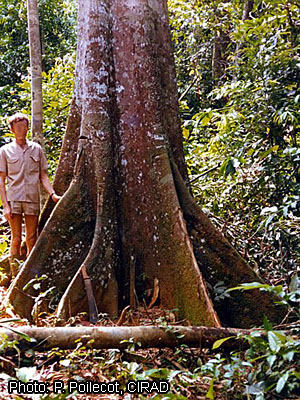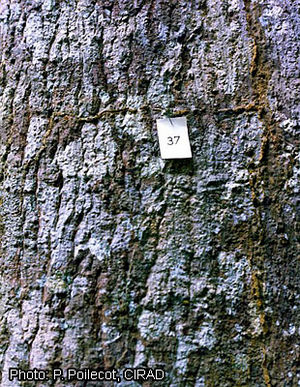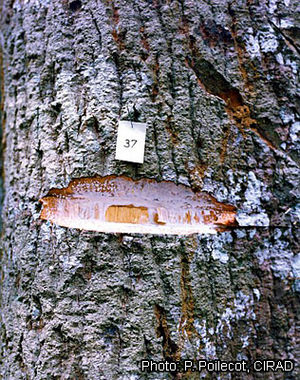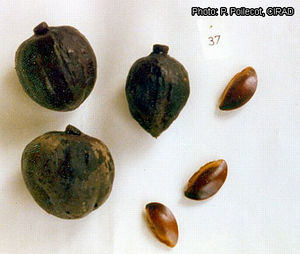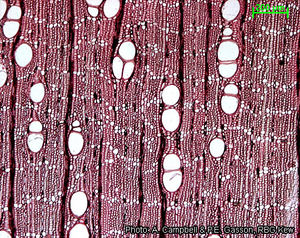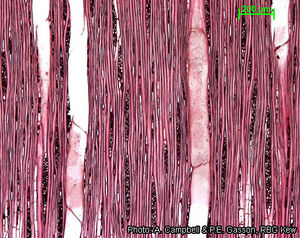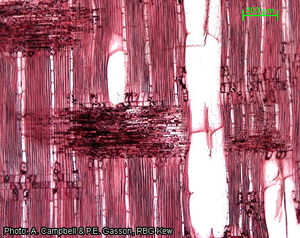Chrysophyllum africanum (PROTA)
Introduction |
Chrysophyllum africanum A.DC.
- Protologue: Prodr. 8: 163 (1844).
- Family: Sapotaceae
- Chromosome number: 2n = 26
Synonyms
- Gambeya africana (A.DC.) Pierre (1891),
- Chrysophyllum edule Hoyle (1932),
- Chrysophyllum delevoyi auct. non De Wild.
Vernacular names
- African star apple (En).
- Longhi, longhi rouge, longui rouge (Fr).
- Cola do obó (Po).
Origin and geographic distribution
Chrysophyllum africanum is widespread from Sierra Leone east to Uganda and south to DR Congo and Cabinda (Angola).
Uses
The wood (trade name: longhi, longui, akatio) is used for carving, moulding, turnery, cabinet making, veneer and plywood. It is also suitable for construction, carpentry, stairs, light flooring, mine props, ships, vehicle bodies, agricultural implements, sporting goods, interior trim, toys and novelties, railway sleepers, particle board and pulp for paper production.
The edible, pleasantly acidulous fruit is often sold on markets. The latex from the bark and young fruit is used as birdlime. A bark infusion is used in traditional medicine as a stomachic and carminative. A maceration of the stem bark is taken to promote lactation. Powdered bark is applied to sores. The fruit is used to treat diarrhoea and vomiting. The seed oil is edible, and the seeds are also used to make soap.
Production and international trade
The timber of Chrysophyllum africanum is traded internationally, but data on volumes are not available due to mixing with other Sapotaceae species. In Côte d’Ivoire it is rated as one of the high-value timbers for export, but it is undoubtedly exported from other countries as well.
Properties
The heartwood is whitish, often with a pinkish tinge when freshly cut, but darkening to yellowish or greyish brown, often with irregular dark stripes, and indistinctly demarcated from the slightly paler sapwood. The grain is straight, occasionally wavy or interlocked, texture fine to moderately fine.
The wood is medium-weight, with a density of 560–810 kg/m³ at 12% moisture content. It dries slowly. The rates of shrinkage are fairly high: 5.8–6.2% radial and 8.1–8.9% tangential from green to oven dry. However, with some care, the wood air dries well with little degrade.
Variation between results of different analyses of the mechanical properties of the wood are large: at 12% moisture content, the modulus of rupture is 78–162 N/mm², modulus of elasticity 12,550–15,885 N/mm², compression parallel to grain 39–74 N/mm², cleavage 11–21 N/mm and Chalais-Meudon hardness 2.4–5.0. The wood is brittle and not very shock-resistant.
The wood is easy to saw, works well with hand and machine tools, and it can be planed to an excellent finish. It does not easily split when nailed, but pre-boring is recommended, and it holds nails and screws well. It has good gluing properties, and peels and slices satisfactorily. The wood is only moderately durable and liable to fungal discoloration and attack by termites and marine borers. It can be treated with preservatives using pressure processes.
The yield of oil from dried seeds is about 25%. The oil is deep red and it has low saponification and iodine values.
Description
- Medium-sized tree up to 25(–35) m tall; bole up to 60(–80) cm in diameter, straight, often fluted or angular, reaching up to 12 m to the first branches, with steep buttresses at base; bark up to 2.5 cm thick, surface greyish brown, fissured, inner bark fibrous, brown, exuding a white sticky latex; crown spreading; young branches greyish brown to reddish brown appressed hairy.
- Leaves arranged spirally in tufts at the ends of branches, simple and entire; stipules absent; petiole 1.5–3.5 cm long, appressed hairy; blade elliptical to obovate-oblong, 15–35 cm × 5–13 cm, cuneate at base, shortly acuminate at apex, greyish brown to reddish brown appressed hairy below, pinnately veined with 15–30 pairs of straight lateral veins.
- Flowers in axillary fascicles, bisexual, regular, 5-merous; pedicel up to 5 mm long; sepals free, broadly ovate, c. 4 mm long, pubescent outside; corolla with c. 3 mm long tube and rounded lobes c. 2 mm long, hairy at margins, creamy white; stamens inserted in corolla tube, opposite corolla lobes; ovary superior, conical, long-hairy, 5-celled, style short, tapering.
- Fruit a large, ovoid to globose berry up to 7 cm long, becoming yellow-orange and glabrous when ripe, slightly pointed at apex, up to 5-seeded.
- Seeds ellipsoid, flattened, up to 3.5 cm × 2 cm, shiny brown.
- Seedling with epigeal germination.
Other botanical information
In Ghana Chrysophyllum africanum flowers in April–May and fruits are mature in December–March.
Chrysophyllum comprises about 70 species and occurs throughout the tropics. Tropical America is richest in species (about 45), followed by continental Africa (about 15), Madagascar (about 10) and tropical Asia and Australia (together 2). The genus has been subdivided into 6 sections, 2 of which (sect. Aneuchrysophyllum and sect. Donella) contain African species. Chrysophyllum africanum belongs to sect. Aneuchrysophyllum.
Chrysophyllum gorungosanum
Chrysophyllum gorungosanum Engl. (synonym: Chrysophyllum fulvum S.Moore) is related to Chrysophyllum africanum, but differs in its smaller leaves and fruits. The wood of Chrysophyllum gorungosanum is used for construction in Uganda, Tanzania and Malawi, but the often strongly fluted bole is a drawback. It is also used for firewood and the production of charcoal. The fruits are edible. In Rwanda an extract of the leaves and roots is drunk and is applied externally as an anodyne.
Ecology
Chrysophyllum africanum occurs in lowland rainforest, often near rivers, up to 1400 m altitude.
Management
In Gabon Chrysophyllum africanum occurs reportedly in low densities (on average 0.11 m³/ha). This is probably also the case elsewhere, and this low density, together with its preference for river banks, makes it difficult to specify management measures to promote this species. The 1000-seed weight is 1.2–1.4 kg.
The wood has to be treated immediately after felling and cutting. Fresh logs do not float in water and have to be transported by truck.
Genetic resources
Chrysophyllum africanum is widespread and does not seem to be in danger of genetic erosion. However, in some countries, e.g. Ghana, it is uncommon and there protection measures may be needed.
Prospects
The role of Chrysophyllum africanum in timber trade is not clear. The timber is harvested and traded together with that of other Sapotaceae species that have timber of comparable colour and density, but the share of each species should be investigated. It seems likely that the amount of Chrysophyllum africanum timber in international trade is limited because of the often comparatively small size of the bole.
Major references
- Aubréville, A., 1959. La flore forestière de la Côte d’Ivoire. Deuxième édition révisée. Tome troisième. Publication No 15. Centre Technique Forestier Tropical, Nogent-sur-Marne, France. 334 pp.
- Bolza, E. & Keating, W.G., 1972. African timbers: the properties, uses and characteristics of 700 species. Division of Building Research, CSIRO, Melbourne, Australia. 710 pp.
- Burkill, H.M., 2000. The useful plants of West Tropical Africa. 2nd Edition. Volume 5, Families S–Z, Addenda. Royal Botanic Gardens, Kew, Richmond, United Kingdom. 686 pp.
- de Saint-Aubin, G., 1963. La forêt du Gabon. Publication No 21 du Centre Technique Forestier Tropical, Nogent-sur-Marne, France. 208 pp.
- Takahashi, A., 1978. Compilation of data on the mechanical properties of foreign woods (part 3) Africa. Shimane University, Matsue, Japan, 248 pp.
Other references
- Ajiwe, V.I.E., Okeke, C.A., Nnabuike, B., Ogunleye, G.A. & Elebo, E., 1997. Applications of oils extracted from African star apple (Chrysophyllum africanum), horse eye bean (Mucuna sloanei) and African pear (Dacryodes edulis) seeds. Bioresource Technology 59(2–3): 259–261.
- Aubréville, A., 1961. Sapotacées. Flore du Gabon. Volume 1. Muséum National d’Histoire Naturelle, Paris, France. 162 pp.
- Chudnoff, M., 1980. Tropical timbers of the world. USDA Forest Service, Agricultural Handbook No 607, Washington D.C., United States. 826 pp.
- Hemsley, J.H., 1968. Sapotaceae. In: Milne-Redhead, E. & Polhill, R.M. (Editors). Flora of Tropical East Africa. Crown Agents for Oversea Governments and Administrations, London, United Kingdom. 79 pp.
- Katende, A.B., Birnie, A. & Tengnäs, B., 1995. Useful trees and shrubs for Uganda: identification, propagation and management for agricultural and pastoral communities. Technical Handbook 10. Regional Soil Conservation Unit, Nairobi, Kenya. 710 pp.
- Kupicha, F.K., 1983. Sapotaceae. In: Launert, E. (Editor). Flora Zambesiaca. Volume 7, part 1. Flora Zambesiaca Managing Committee, London, United Kingdom. pp. 210–247.
- Liben, L., 1989. A propos de Gambeya africana (A. DC.) Pierre (Sapotaceae). Bulletin du Muséum national d’Histoire naturelle, 4e série, 11, section B, Adansonia, no 4: 459–460.
- Neuwinger, H.D., 2000. African traditional medicine: a dictionary of plant use and applications. Medpharm Scientific, Stuttgart, Germany. 589 pp.
- Raponda-Walker, A. & Sillans, R., 1961. Les plantes utiles du Gabon. Paul Lechevalier, Paris, France. 614 pp.
- Wilks, C. & Issembé, Y., 2000. Les arbres de la Guinée Equatoriale: Guide pratique d’identification: région continentale. Projet CUREF, Bata, Guinée Equatoriale. 546 pp.
Author(s)
- R.H.M.J. Lemmens, PROTA Network Office Europe, Wageningen University, P.O. Box 341, 6700 AH Wageningen, Netherlands
Correct citation of this article
Lemmens, R.H.M.J., 2007. Chrysophyllum africanum A.DC. In: Louppe, D., Oteng-Amoako, A.A. & Brink, M. (Editors). PROTA (Plant Resources of Tropical Africa / Ressources végétales de l’Afrique tropicale), Wageningen, Netherlands. Accessed 31 May 2025.
- See the Prota4U database.

